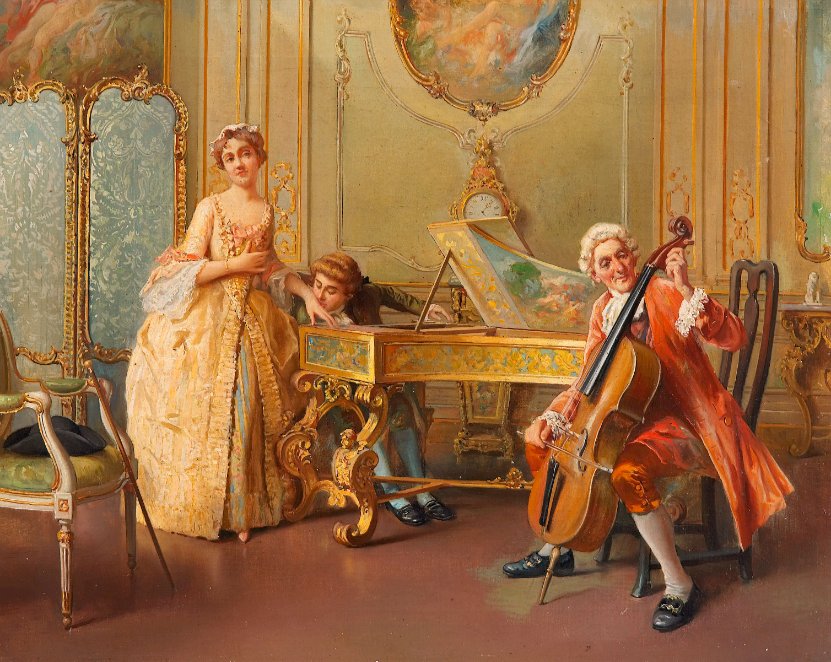
Enjoy the accurate listening guide that Paolo Motta wrote for Theresia’s concert in Lodi.
Carl Philip Emanuel Bach was the second, and probably the most famous, of Johann Sebastian Bach’s twenty sons. Since 1740 he had been harpsichordist in the music chapel of the Prussian King Frederick the Great: he performed with the king, who was an excellent amateur flutist. In 1768 he succeeded Telemann as musical director and Kantor in Amburg Johanneum. He was a prolific composer and a point of reference for Haydn and Mozart. He was highly appreciated also by Beethoven (mainly for the harpsichordist opus), and then by Mendelssohn, Schumann and Brahms.
During Theresia concert we will listen to the E minor Symphony Wq 178, one of the nine “Berlin Symphonies”: it was originally composed for strings, and later enriched with the addition of flutes, oboes and horns. It was composed in 1756 and it consists of three movements: at first, an Allegro full of tension, as rarely happened at that time; at the end, a second Allegro very rhythmical. In the middle, a delightful Andante, quite contrasting, a fine example of “gallant style”, to which the sound of flutes gives a particular taste.
Johann Christian Bach was the eleventh son of Johann Sebastian and his second wife, Anna Magdalena. After his father died, when JC was fourteen, he moved to Berlin where he stayed with his brother Carl Philip Emanuel and studied Harpsichord and Composition. In 1754 he left Berlin and traveled to Italy: he studied in Bologna with Padre Martini and in Milan with G. B. Sammartini. After he converted to Catholicism, in 1760 he became main organist in the Milan Cathedral. In 1762 he left Milan, for reasons that remained obscure: he moved to London, where he lived till his death and where he had a huge success (also in the field of opera, as a follower of Neapolitan school) becoming chapel Master of Queen Charlotte. Yet, his luck did not last long and he died before time and overwhelmed by debts. His music is far away from his father’s style and from CPE’s style too, due to the more relevant melodic principle. In any case, he is considered one of the most important composers of his time: he wrote principally in the gallant style, even if he is included among the main precursors of the Viennese classicism. He had a huge influence on Mozart.
The “simphonie concertante” is a typical form of the Classical period, and it can be described as a mixture between a symphony and a concert: it’s a concert because it has more than a soloist, and it’s a symphony because soloist are not in particular emphasis, except in few moments. The masterpieces in this genre were written – coincidentally… – by Mozart and Haydn. The Symphonie concertante C44 for flute, two violins, cello and orchestra opens with a lively introduction: then, the two violins and the cello are put in relief, often exchanging solos; in the Andante the flute is the absolute star, exposing sweetly sorrowful melodic lines. The Finale (Allegro Molto) is definitely more symphonic.
“L’isola disabitata” (“The uninhabited island”) is an opera composed by Franz Joseph Haydn in 1779: according to music historians, it represents the composer’s attempt to abandon the Italian “opera seria” style and update his style on the model carried forward by Gluck. The opera wasn’t successful, not at its time, neither in later reprises. Yet the Overture stayed firmly in the orchestral repertoire, due to the dramatic atmosphere and the characteristics that make it like a miniature Symphony, split in four sections with alternate fast and slow movements.
Luigi Boccherini was a great cellist and a prolific composer: he is considered the most representative composer of instrumental music in Latin European countries during the first Classicism. After some experiences in Vienna, Rome and Paris, he moved ultimately to Spain, into the service of Infante Don Luis: when Don Luis died, he establishes a long-distance relationship with Frederick William II, King of Prussia, for whom he composed a lot of music, including – in 1789 – the Symphony in D op. 42. It’s a composition of huge dimensions, with a wind section larger than the usual: it consists in flute, two oboes, two bassoons and two horns. The opening Allegro has a rather dramatic tone and is based substantially on a unique theme that develops through different combinations of instruments in dialogue one with each other. The Andante is particularly interesting, mainly for winds, with flute in evidence, while the strings provide a support made of emphases and brief interludes of dramatic recitative type. The Minuet is rigorous in the structure and in the rhythmical pattern: it’s in the Haydn’s style, with sharp moments for violin and bassoon. The final Presto is a lively, rhythmically engaging, with a clever dialogue of strings and horns.


